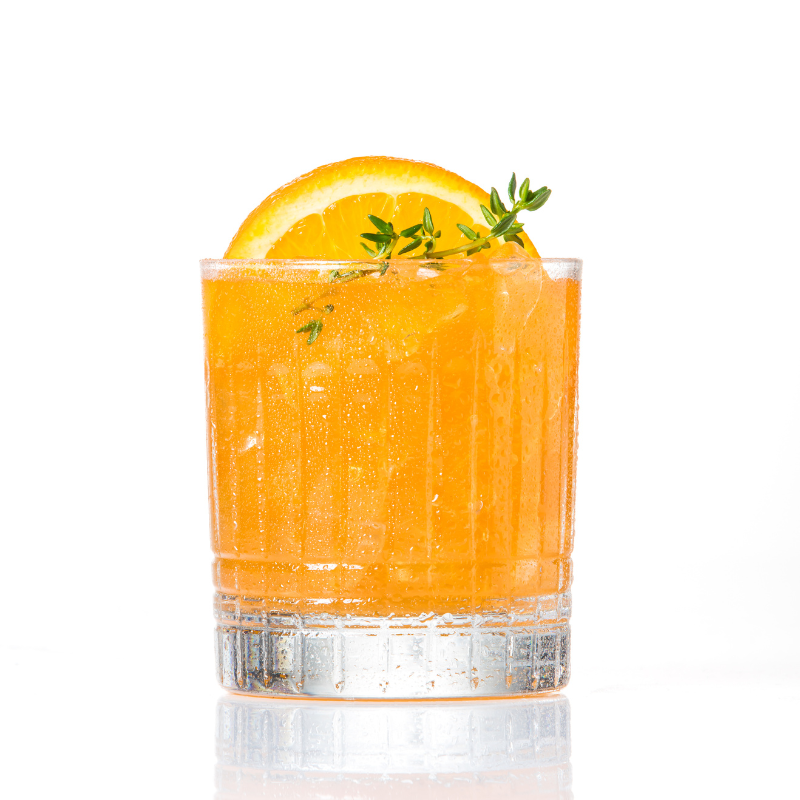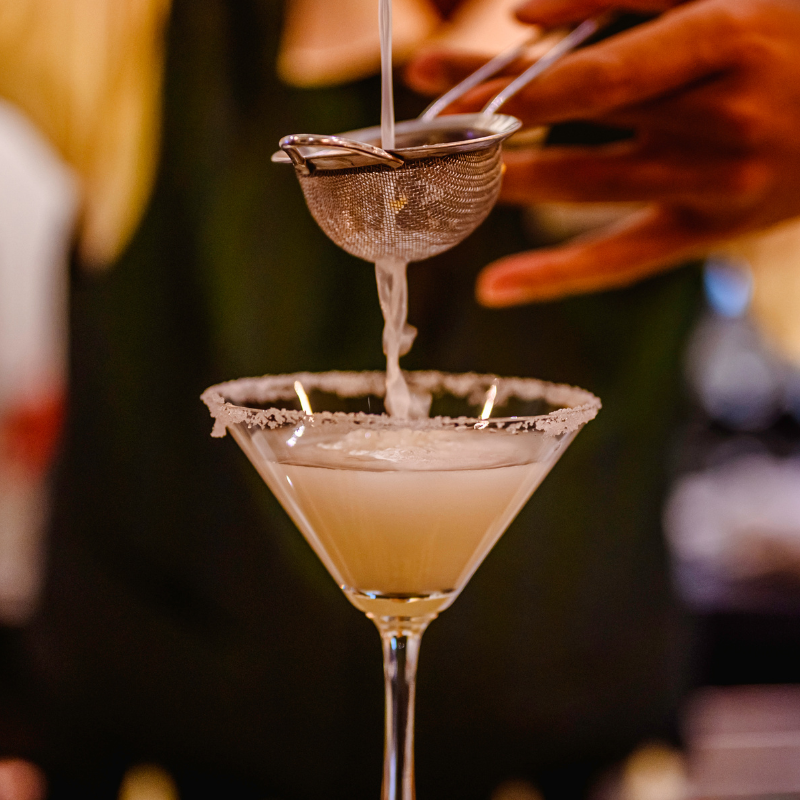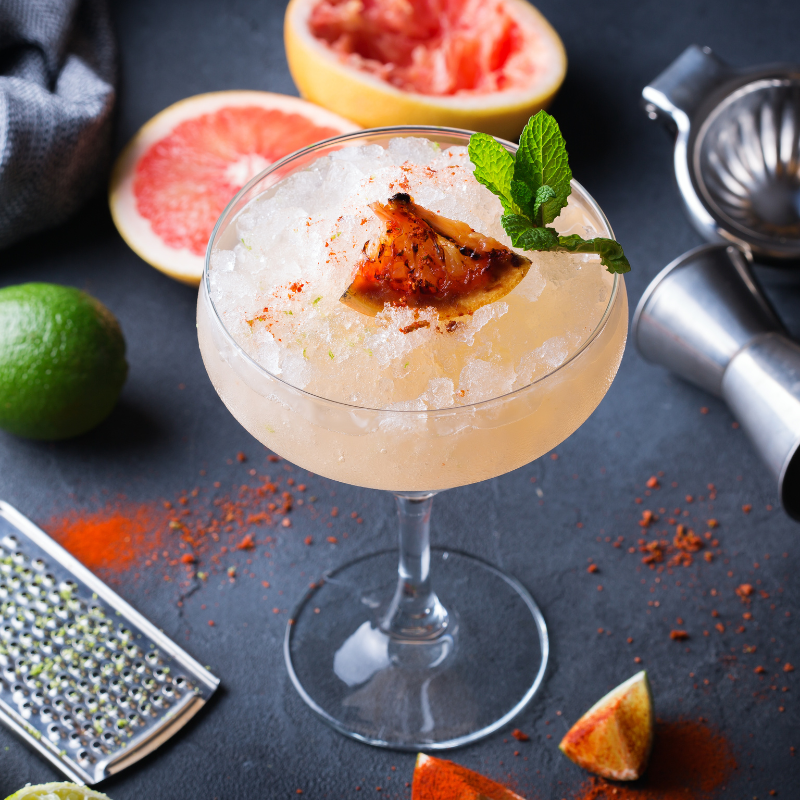Remember your first sip at a craft cocktail that blew your mind?
Maybe it was the subtle sweetness of a perfectly balanced Old Fashioned or the bold flavors of a spicy Margarita. Whatever it was, it likely sparked a curiosity about the art of cocktail tasting.
Developing a refined cocktail palate is a journey that unlocks a world of flavors and elevates your appreciation for mixology.
You can elevate your drinking experience from casual enjoyment to connoisseurship by understanding the nuances of taste, aroma, and texture.
In this article, we'll take you through the steps to develop your cocktail palate, from the basics of taste and smell to advanced techniques for identifying flavor profiles and nuances.
1. Understand the basics
Developing a refined cocktail palate begins with a better understanding of the fundamentals. In this step, we'll explore the essential ingredients, classic cocktail categories, and basic tasting notes that will lay the groundwork for your journey.
Key ingredients and their flavor profiles
Understanding the key ingredients and their distinct flavor profiles is essential for developing a cocktail palate.
Spirits like vodka, gin, rum, tequila, and whiskey each bring unique characteristics to a drink.
- Gin: Known for its botanical, crisp, and dry flavor profile, with notes of juniper, coriander, and citrus.
- Rum: Typically sweet, tropical, and spicy, with hints of vanilla, caramel, and oak.
- Whiskey: Rich, oaky, and smoky, with flavors of vanilla, caramel, and toasted nuts.
Mixers like tonic water, club soda, and fruit juices also contribute significantly to the overall flavor, adding sweetness, bitterness, or acidity.
- Triple Sec: Sweet, citrusy, and slightly bitter, with a strong orange flavor.
- Vermouth: Herbaceous, slightly sweet, and bitter, with notes of botanicals and spices.
Common cocktail categories
Familiarizing yourself with common cocktail categories can enhance your tasting experience. Classic cocktails such as martinis, old-fashioneds, and sours each have distinct structures and flavor profiles.
Here are a few examples:
- Martinis: Spirit-forward, dry, and crisp, often featuring gin or vodka, with a focus on botanicals and citrus.
- Old fashioneds: Spirit-forward, sweet, and spicy, typically made with whiskey or bourbon, with a focus on oak, vanilla, and bitters.
- Sours: Citrusy, tangy, and refreshing, usually featuring whiskey or gin, with a focus on balance and acidity.
Basic tasting notes and terminology
To effectively describe and communicate your experience of a cocktail, it's essential to develop a basic vocabulary. Start with simple descriptors like:
- Sweet, sour, bitter, salty, and umami: These five tastes form the foundation of flavor perception.
- Fruity, floral, herbal, and spicy: These descriptors will help you identify common flavor profiles and aromas.
- Crisp, smooth, rich, and refreshing: These textures and sensations will enhance your understanding of a cocktail's overall character.
- Aroma, mouthfeel, and finish: Helps articulate the sensory experience. Aroma is the scent of the cocktail, mouthfeel describes the texture on your palate, and finish refers to the lingering taste after swallowing.
2. Expand your flavor palette
Now that you've established a solid foundation in the basics, it's time to expand your flavor palette and explore the vast world of spirits, liqueurs, bitters, sweeteners, and acids.
Exploring different spirits
To truly appreciate the artistry of mixology, you must venture beyond the familiar.
Start by exploring the diverse spirits. While vodka might seem neutral, different brands offer subtle variations in taste. Gin, with its botanical complexity, can range from juniper-forward to floral and citrusy.
Rum, whiskey, tequila, and other spirits each have their unique characteristics that influence the final flavor of a cocktail.
Experimenting with liqueurs and bitters
Once you've mastered the base spirits, you can explore liqueurs and bitters, which add depth, complexity, and balance to your drinks.
Experiment with sweet liqueurs like triple sec, amaretto, or Cointreau. Explore the bitter side with Angostura, Campari, or Peychaud's bitters. Learning how these ingredients interact with different spirits is key to crafting exceptional cocktails.
Understanding the role of sweeteners and acids
Sweeteners and acids are the yin and yang of cocktail balance. Simple syrup, agave nectar, and fruit juices provide sweetness, while citrus juices like lemon and lime offer acidity that counterbalances sweetness.
These components are essential for creating harmonious flavors. Experiment with different sweeteners and acids to discover how they complement various spirits and liqueurs.
3. Develop tasting skills
This step will help you develop a systematic approach to evaluating cocktails and identifying their flavor components.
The tasting process: sight, smell, taste, finish
The art of cocktail tasting involves engaging all your senses. Begin by visually inspecting the drink. Notice its color, clarity, and any garnishes. Your observations can provide clues about the flavors within.
Next, take a deep breath and inhale the cocktail's aroma. Your olfactory senses play a crucial role in taste perception. Identify the primary aromas, such as citrus, spice, or floral notes. These scents will prepare your palate for the flavors to come.
Finally, take a sip and let the cocktail wash over your tongue. Pay attention to the initial taste, the mid-palate development, and the finish.
A good finish should be pleasant and can reveal additional flavors that weren’t apparent initially. Note how long the finish lasts and whether it leaves a clean or lingering impression.
Identifying flavor components
Identify the dominant flavors and how they evolve over time. Note the balance of sweet, sour, bitter, and flavor compounds. Practice describing the texture of the drink, whether it's smooth, oily, or crisp.
Start by focusing on primary flavors, such as the spirit's core taste and the sweetness from syrups or liqueurs. Then, detect secondary flavors like citrus notes from fresh juices or herbal nuances from bitters. These components will help you better appreciate the complexity of well-crafted cocktails.
With each sip, your palate becomes more refined. Keep a tasting journal to record your impressions and track your progress. Over time, you'll develop a keen ability to identify complex flavors and understand how different ingredients interact.
Recognizing balance and harmony in a cocktail
A well-balanced cocktail achieves harmony among its ingredients, creating a seamless blend of flavors that complement each other. Recognizing this balance involves evaluating how the primary tastes (sweet, sour, bitter, salty, umami) interact.
Pay attention to whether any flavor dominates or if they all meld together smoothly. A balanced cocktail should be cohesive, with no single element overpowering the others, leading to a more enjoyable and sophisticated drinking experience.
4. Explore cocktail techniques

It’s time to explore the techniques that bring cocktails to life. Different drinks require different preparation methods. Some methods include:
- Shaking This method introduces air, dilutes, and chills ingredients. It is ideal for cocktails with citrus, cream, or eggs. Classic examples include Margaritas, Daiquiris, and Whiskey Sours.
- Stirring: This method preserves clarity, minimizes dilution, maintains texture, and is suited for spirit-forward cocktails like Martinis and Manhattans.
- Building: Layers ingredients in a glass, often used for highball-style cocktails.
Break free from sugary mixers and calories! DrinkPax offers a convenient, guilt-free, and deliciously fun way to enjoy your favorite cocktails.
The impact of glassware on cocktail perception

The choice of glassware can influence the overall drinking experience by affecting the aroma, temperature, and presentation of the cocktail. Different glasses are designed to enhance specific types of drinks:
- Martini glass: Its wide bowl allows the aromas to concentrate near the surface, enhancing the olfactory experience. The long stem prevents your hand from warming the drink.
- Highball glass: Tall and narrow, it’s perfect for building cocktails with lots of ice and mixers. The shape helps maintain carbonation and keeps the drink refreshing.
- Old-fashioned glass: Also known as a rocks glass, this glass is ideal for spirit-forward drinks served on the rocks. Its wide mouth allows you to fully appreciate the drink's aroma.
- Coupe glass: This glass has a shallow, broad bowl and is often used for shaken or stirred cocktails served without ice. Its shape helps keep the drink cool and showcases its clarity.
Garnishes and their role
Garnishes are more than just decorative; they play a crucial role in enhancing a cocktail’s flavor and presentation.
They can add aromatic elements, visual appeal, and additional tastes that complement or contrast with the drink’s primary flavors.
- Citrus zest: A twist of lemon or lime peel can add a burst of citrus aroma and a hint of bitterness.
- Herbs: Fresh herbs like mint, basil, or rosemary can contribute aromatic complexity and a touch of herbal flavor.
- Fruits and berries: Adding slices of fruit or berries can enhance the drink’s visual appeal and provide a fresh, fruity note. You can even add the fruits to your ice cubes, elevating your presentation.
- Spices: A sprinkle of cinnamon, nutmeg, or other spices can introduce warmth and depth to the cocktail’s flavor profile.
5. Incorporate advanced tasting and analysis
You've refined your palate and mastered techniques; now it's time to take your cocktail journey to the next level by doing the following:
Learning how to pair cocktails with food
Pairing cocktails with food is an advanced skill that can elevate both your dining and drinking experiences. The goal is to learn:
Complementary pairings
Match flavors that naturally go well together, such as a citrusy Margarita with spicy Mexican cuisine. The acidity of the Margarita can balance the heat of the spices, creating a harmonious taste.
Contrasting pairings
Pairing contrasting flavors can also be delightful. For instance, an Old Fashioned’s sweetness and bitterness can complement the rich, savory flavors of a steak, cutting through the fat and enhancing the meat’s taste.
Texture and weight
Light, refreshing cocktails pair well with delicate dishes, while robust, spirit-forward cocktails are better suited for heavier, richer foods. A light Gin and Tonic pairs nicely with seafood, whereas a bold Manhattan might be perfect with a hearty beef dish.
Understanding the history and culture of cocktails
Understanding the history and culture of cocktails is essential to refining your palate. Learning where different cocktails originate and how they have evolved enables you to gain insight into the ingredients, techniques, and traditions that shape their flavors. This knowledge helps you to appreciate the nuances in each drink, making your tasting experience more informed and enjoyable.
Creating your own cocktail recipes
Crafting your own cocktails involves starting with a base spirit you enjoy and experimenting with complementary flavors. Focus on balancing sweetness, acidity, and bitterness to achieve a harmonious mix.
Don’t hesitate to experiment with unique ingredients and techniques, refining your recipe based on taste and feedback. Presentation and garnish also play a key role in enhancing the overall experience.
6. Apply continuous learning
Your cocktail journey doesn't end here! Continuous learning is key to refining your palate and staying inspired. Attend tastings and events to immerse yourself in the vibrant cocktail scene. These experiences offer opportunities to discover new flavors, learn from experts, and connect with fellow enthusiasts.
Expand your horizons by joining cocktail clubs or online communities. Engaging with like-minded individuals fosters knowledge sharing and inspires creativity.
Document your cocktail adventures in a dedicated journal. Record tasting notes, recipes, and personal reflections. This practice enhances your memory and helps track your progress.
Takeaway: Master the art of cocktail tasting like an experienced pro
Embarking on a journey to develop your palate is a sensory adventure that will transform your relationship with cocktails.
Each step, from exploring different spirits and techniques to creating your own recipes, contributes to a more sophisticated drinking experience.
Continuous learning through tastings, community engagement, and journaling further helps you develop your palate, allowing you to savor cocktails with greater depth and enjoyment.
Discover how our wellness cocktail and mocktail mixes can complement your exploration of cocktails and help you build a sophisticated palate. Visit Drink Pax to explore our range of products and start your journey to refined taste.






Leave a comment (all fields required)